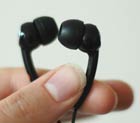



Personal music players are portable devices that play audio files, such as MP3 files, using earphones or speakers. In addition, many of these devices can store videos and pictures, and podcast radio and TV programmes. Personal music players are used widely for leisure activities or work purposes, and some children use them as toys.
To identify the risk of exposure to sound from personal music players, it is useful to understand how music is recorded and reproduced as this influences the level and quality of sound output delivered by the personal music player.
The volume of the sound emitted by personal music players varies from manufacturer to manufacturer, and is difficult to estimate. The amount of sound energy that reaches the eardrum also depends on the type of music, on the type of headphone used, and in the case of ear-buds on how deeply they are inserted in the ear canal. In general, the smaller the headphone, the greater the amount of sound energy transmitted for a given volume setting. A study showed that for a given volume setting of the player, ear-bud type headphones produce a sound output that is 7-9 dB(A) higher than that of standard headphones.
So, sound levels from personal music players depend on a series of factors. With the digital formats of sound recording and reproduction currently available, such as MP3, it is possible to reach high levels of sound output without distortion. At the maximum volume setting, sound pressure levels reaching the eardrum can range from 91 to about 121 dB(A) for different player-headphone combinations. More...

This summary is free and ad-free, as is all of our content. You can help us remain free and independant as well as to develop new ways to communicate science by becoming a Patron!